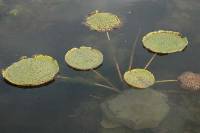|
This section of the web site reviews each
year of our adventure, with details not found in other sections
of the site -- things like plant and flower numbers, successes
and failures, big and small things we've learned. It also discusses
things we want to do, things we want to know, things we speculate
about. It is sequential, often with questions raised one year
answered the next. We don't go back and rewrite.
Our Adventure With Victoria 2007
Weird
by Kit & Ben Knotts - Click images
to enlarge |

Reflection 12/2/07 |
|
2007, our tenth year of producing seeds on purpose, was a
very good one in many ways but strange in others. Amazonica and
cruziana reversed roles, with amazonica quitting early and cruziana
going into 2008. This was exactly opposite of previous years
and we are still baffled by it. Much of what we have learned
and are learning continues through the winter.
In the main part of the season we grew 13 plants to flowering
and seed-producing size. Our seed crop was large and well-balanced
among species and hybrids. The amazonicas were a mix of straight
lines and crossed ones; the cruzianas were several each of Argentine,
Paraguayan and domestic straight lines. We enjoyed a record number
of flowers, nearly 400. |

Reflection 12/30/07 |

V. 'Adventure' 12/17/07 |
Of course 'Adventure' was as always a blooming fool, producing
72 flowers after the first 10 buds were cut off. It bloomed into
January 2008, even with the crown completely out of the water.
Though leaves and buds continued to develop, they eventually
dried out too much to survive.
We were unable to grow 'Longwood Hybrid' to adulthood at all.
We planted two in succession in the Victoria Pool where they
failed to thrive. We just have to accept that the interior part
of the garden no longer has enough sun for Victoria - they want
the full blazing sun of the dune ponds. An 'Adventure' planted
in Victoria in the fall, when the house didn't block the light
as much as in summer, bloomed several times before high winds
damaged its pads beyond recovery. |
|
None of the dune side plants achieved the size they do most years,
which may be a factor in the longevity of some. This was also
the case with some waterlilies. Our fertilizing schedule was
the same as previous years; the weather was neither abnormally
cool nor hot. It was very dry throughout the state and we have
speculated that might have affected water quality in the underground
aquifer and thereby the plants. |
|
Cruziana usually grows fast, blooms like crazy, matures its pods,
declines and dies by September or October. One plant did that
in 2007 but the others kept right on going. One plant produced
its 45th flower in November, another its 52nd in January and
yet another its 68th also in January. These are far and away
the most flowers we have ever had on cruziana plants, with the
average more like 30 per plant. |
|
Two cruziana plants remained alive in early February 2008. Sand
was added around the crown of one plant several times but none
was added to the other. Both crowns were nearing the surface,
in obvious decline, but were alive. In early March one remains
alive, pushed over. |
 |
< V. cruziana
New Year's Day 2008
V. cruziana
2/26/08 > |
 |
|
The early demise of the amazonicas is easier to explain in all
cases but two. They were repeatedly wind damaged in the fall
and, being the slowest growers of all, simply couldn't recover.
One plant behaved more like cruziana, getting up to size quickly,
making six quick flowers, and dying by mid-October. |
|
Another was even stranger! It produced flowers but shed its
pods prematurely. At the same time it was putting up distorted
pads and shrinking, this in August, when most amazonicas are
just getting going. We dug it up before it died, dissecting the
crown to see if we could find a reason for the aberrations. See
Stranger
and Stranger!
A distorted infant amazonica pad
> |
 |
|
Usually amazonica is a totally reliable pollen producer. In 2007,
two plants made little if any pollen in August. One was the distorted
one mentioned above -- understandable. The other was a perfectly
healthy plant and most flowers opened normally. They just didn't
dehisce pollen. By September the pollen was fine again. |

'Adventure' in Treasures 2/27/08 |
Sometimes we still get caught up in preconceptions. One of these
is that once our current year plants die, we have to wait for
spring for the next round. In 2007 we had several stalled hybrids
(Speaking
of Stalling) that we decided to plant in Treasures in mid-October.
They made it through our coldest day and months, shrinking but
still healthy, and the 'Adventure' has bloomed occasionally in
January, February and early March. Why
Is That? |
|
On the subject of seed germination, the primary hybrids were
fairly reliable but the back-cross hybrids performed poorly.
Where amazonica used to be the species difficult to germinate,
now it is cruziana that's very stubborn.
We are trying several different storage temperatures for cruziana.
We see almost no sprouting of seeds stored at 76 F (24 C) but
there is some improvement when seeds are stored at 60 F (15 C).
There is no germination of our seeds stored at 45 F (7 C) but
others have reported good germination when seeds accidentally
approached freezing.
The above applies only to cruziana. 'Adventure' and amazonica
seeds still need to be kept at about 76 F (24 C). 'Longwood Hybrids'
can be stored at 60 F (15 C) to prevent premature sprouting.
V. amazonica > |

V. cruziana |
 |
|








